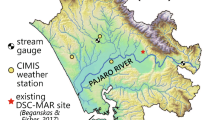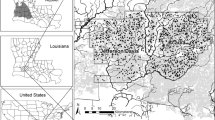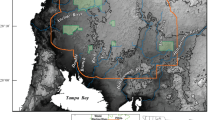Abstract
Excessive nitrate-nitrogen (nitrate) loss from agricultural watersheds is an environmental concern. A common conservation practice to improve stream water quality is to retire vulnerable row croplands to grass. In this paper, a groundwater travel time model based on a geographic information system (GIS) analysis of readily available soil and topographic variables was used to evaluate the time needed to observe stream nitrate concentration reductions from conversion of row crop land to native prairie in Walnut Creek watershed, Iowa. Average linear groundwater velocity in 5-m cells was estimated by overlaying GIS layers of soil permeability, land slope (surrogates for hydraulic conductivity and gradient, respectively) and porosity. Cells were summed backwards from the stream network to watershed divide to develop a travel time distribution map. Results suggested that groundwater from half of the land planted in prairie has reached the stream network during the 10 years of ongoing water quality monitoring. The mean travel time for the watershed was estimated to be 10.1 years, consistent with results from a simple analytical model. The proportion of land in the watershed and subbasins with prairie groundwater reaching the stream (10–22%) was similar to the measured reduction of stream nitrate (11–36%). Results provide encouragement that additional nitrate reductions in Walnut Creek are probable in the future as reduced nitrate groundwater from distal locations discharges to the stream network in the coming years. The high spatial resolution of the model (5-m cells) and its simplicity may make it potentially applicable for land managers interested in communicating lag time issues to the public, particularly related to nitrate concentration reductions over time.







Similar content being viewed by others
References
Bohlke JK, Denver JM (1995) Combined use of groundwater dating, chemical, and isotopic analyses to resolve the history and fate of nitrate contamination in two agricultural watersheds, Atlantic Coastal Plain. Water Resour Res 31:2319–2339
Browne BA, Guldan NM (2005) Understanding long-term baseflow water quality trends using a synoptic survey of the ground water-surface water interface, central Wisconsin. J Environ Qual 34:825–835
Burkart MR, James DE (1999) Agricultural-nitrogen contributions to hypoxia in the Gulf of Mexico. J Environ Qual 28:850–859
Dinnes DL, Karlen DL, Jaynes DB, Kasper TC, Hatfield JL, Colvin TS, Cambardella CA (2002) Nitrogen management strategies to reduce nitrate leaching in tile-drained Midwestern soils. Agron J 94:153–171
Dodds WK, Welch EB (2000) Establishing nutrient criteria in streams. J N Am Benth Soc 19:186–196
Drobney PM (1994) Iowa prairie rebirth, rediscovering natural heritage at the Walnut Creek National Wildlife Refuge: restoration & management notes 12:16–22
Goolsby, DA, Battaglin WA, Lawrence GB, Artz RS, Aulenbach BT, Hooper RP, Keeney DR, Stensland GJ (1999) Flux and sources of nutrients in the Mississippi-Atchalfalalya River Basin. White House Office of Science and Technology Policy Committee on Environmental and Natural Resources Hypoxia Work Group
Haitjema HM (1995) On the residence time distribution in idealized groundwatersheds. J Hydrol 172:127–146
Hallberg GR (1987) Nitrates in ground water in Iowa. In: D’Itri FM, Wolfson LG (eds) Rural ground water contamination. Lewis, Chelsea, pp 23–68
Harbaugh AW, Banta ER, Hill MC, McDonald MG (2000) MODFLOW-2000, the U.S. Geological Survey modular ground-water model-user guide to modularization concepts and the ground-water flow process. USGS Open-File Report 00-92, Reston, Virginia
Helmke MF, Simpkins WW, Horton R. (2004). Fracture-controlled nitrate and atrazine transport in four Iowa tills. J Environ Qual 34:227–236
Nestrud LM, Worster JR (1979) Soil survey of Jasper County. US Department of Agriculture, Soil Conservation Service, Iowa, p 136
McDonald MG, Harbaugh AW (1988) A modular three-dimensional finite-difference ground-water flow model. Techniques of Water Resources Investigations of the United States Geological Survey, Chap A1, Book 6, Modeling techniques
Meals, D, Dressing S (2006) Lag time in water quality response to land treatment. NWQEP Notes Number 122. N.C. State University Cooperative Extension Raleigh, N.C
Modica E, Buxton HT, Plummer LN (1998) Evaluating the source and residence times of groundwater seepage to streams, New Jersey Coastal Plain. Water Resour Res 34:2797–2810
Prior JC (1991) Landforms of Iowa. University of Iowa Press, Iowa City, 153 p
Rabalais NN, Wiseman WJ, Turner RE, Sen Gupta BK, Dortch Q (1996) Nutrient changes in the Mississippi River and system responses on the adjacent continental shelf. Estuaries 19:386–407
Rodvang SJ, Simpkins WW (2001) Agricultural contaminants in quaternary aquitards: a review of occurrence and fate in North America. Hydrogeol J 9:44–59
Schilling KE (2002) Chemical transport from paired agricultural and restored prairie watersheds. J Environ Qual 31:1184–1193
Schilling KE, Spooner J (2007) Effects of watershed scale land use change on stream nitrate concentrations. J Environ Qual (in press)
Schilling KE, Wolter CF (2001) Contribution of baseflow to nonpoint source pollution loads in an agricultural watershed. Ground Water 39:49–58
Schilling KE, Wolter CF (2006) Evaluating the timeframe for measuring changes in stream nitrate concentrations from large-scale land use change. Managing Agricultural Landscapes fro Environmental Quality: Strengthening the Science Base. Soil and Water Conservation Society meeting, October 11–13, 2006, Kansas City
Schilling KE, Zhang YK (2004) Contribution of baseflow to nitrate-nitrogen export in a large agricultural watershed, USA. J Hydrol 295:305–316
Schilling KE, Zhang YK, Drobney P (2004) Water table fluctuations near an incised stream, Walnut Creek, Iowa. J Hydrol 286:236–248
Schilling KE, Hubbard T, Luzier J, Spooner J (2006a) Walnut Creek watershed restoration and water quality monitoring project: final report. Iowa Department of Natural Resources, Geological Survey Bureau Technical Information Series 49, Iowa City
Schilling KE, Li Z, Zhang YK (2006b) Groundwater-surface water interaction in the riparian zone of an incised channel, Walnut Creek, Iowa. J Hydrol 327:140–150
Tomer MD, Burkart MR (2003) Long-term effects of nitrogen fertilizer use on ground water nitrate in two small watersheds. J Environ Qual 32:2158–2171
Acknowledgments
The Walnut Creek Nonpoint Source Monitoring Project was supported in part by Region VII of the US Environmental Protection Agency through a 319-Nonpoint Source Program grant to the Iowa Department of Natural Resources. Additional support was provided by US Department of Agriculture Cooperative State Research, Education, and Extension Service grant 2004-51130-03120. The Neal Smith National Wildlife Refuge contributed greatly to the success of the project.
Author information
Authors and Affiliations
Corresponding author
Rights and permissions
About this article
Cite this article
Schilling, K.E., Wolter, C.F. A GIS-based groundwater travel time model to evaluate stream nitrate concentration reductions from land use change. Environ Geol 53, 433–443 (2007). https://doi.org/10.1007/s00254-007-0659-0
Received:
Accepted:
Published:
Issue Date:
DOI: https://doi.org/10.1007/s00254-007-0659-0




